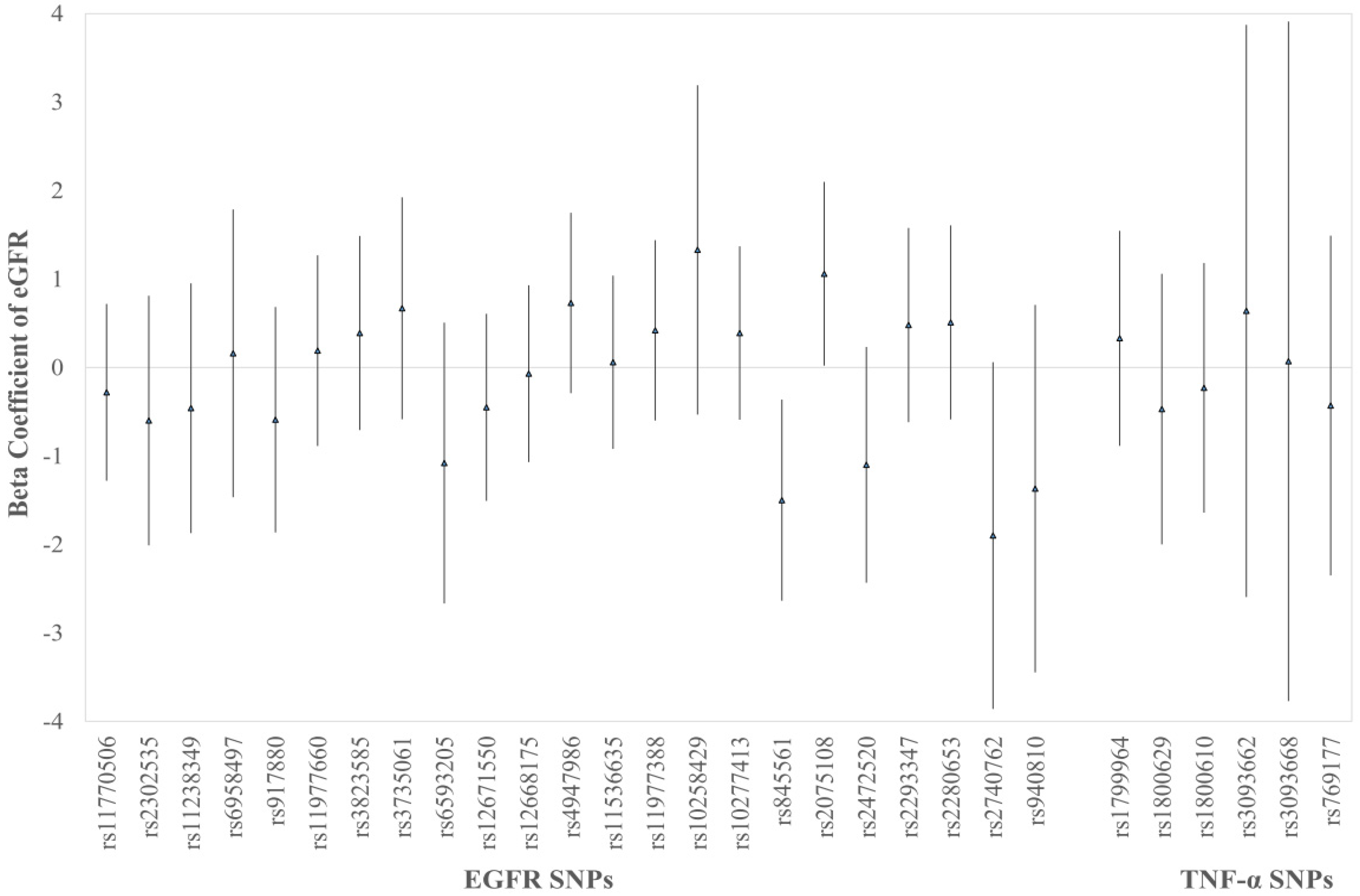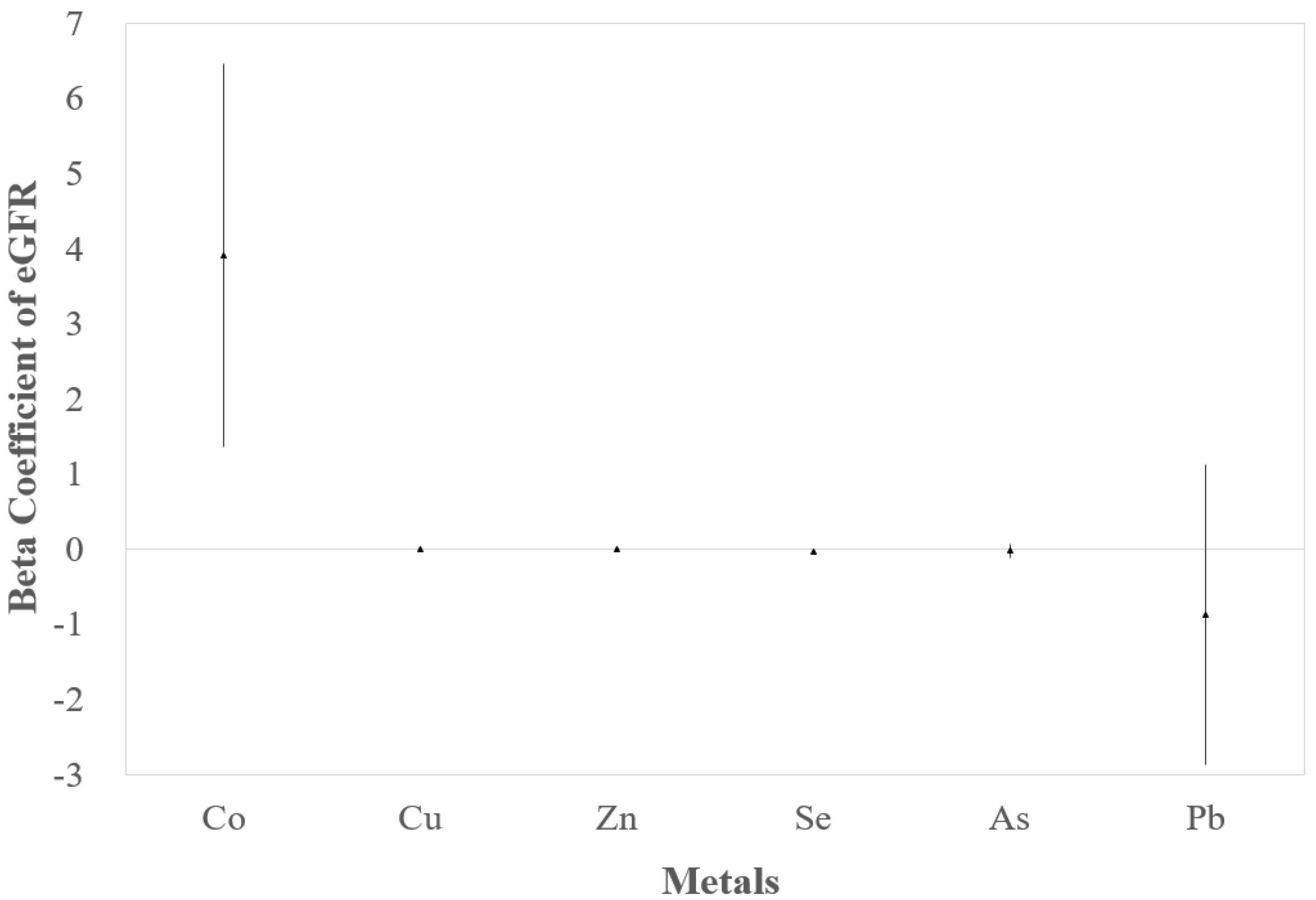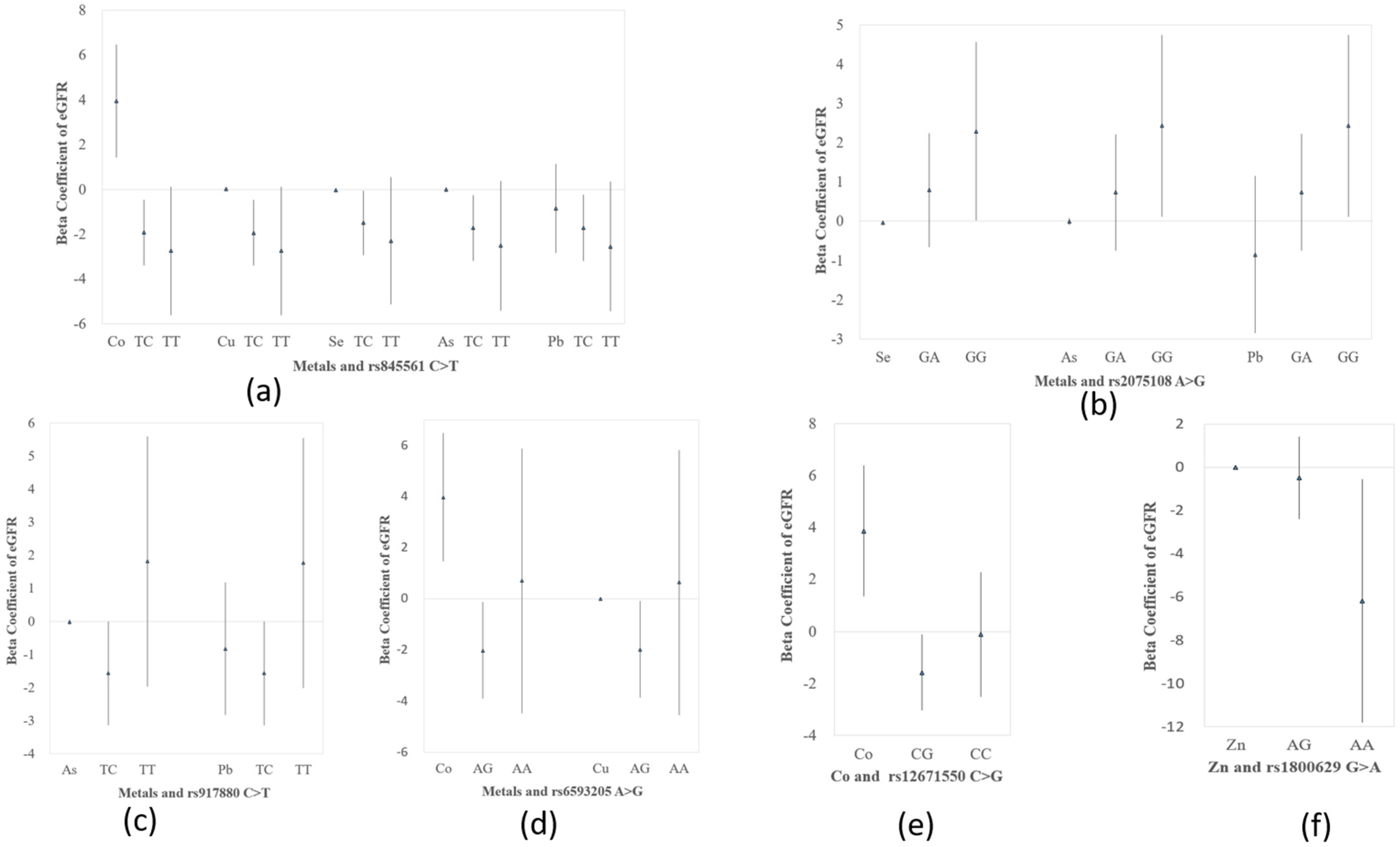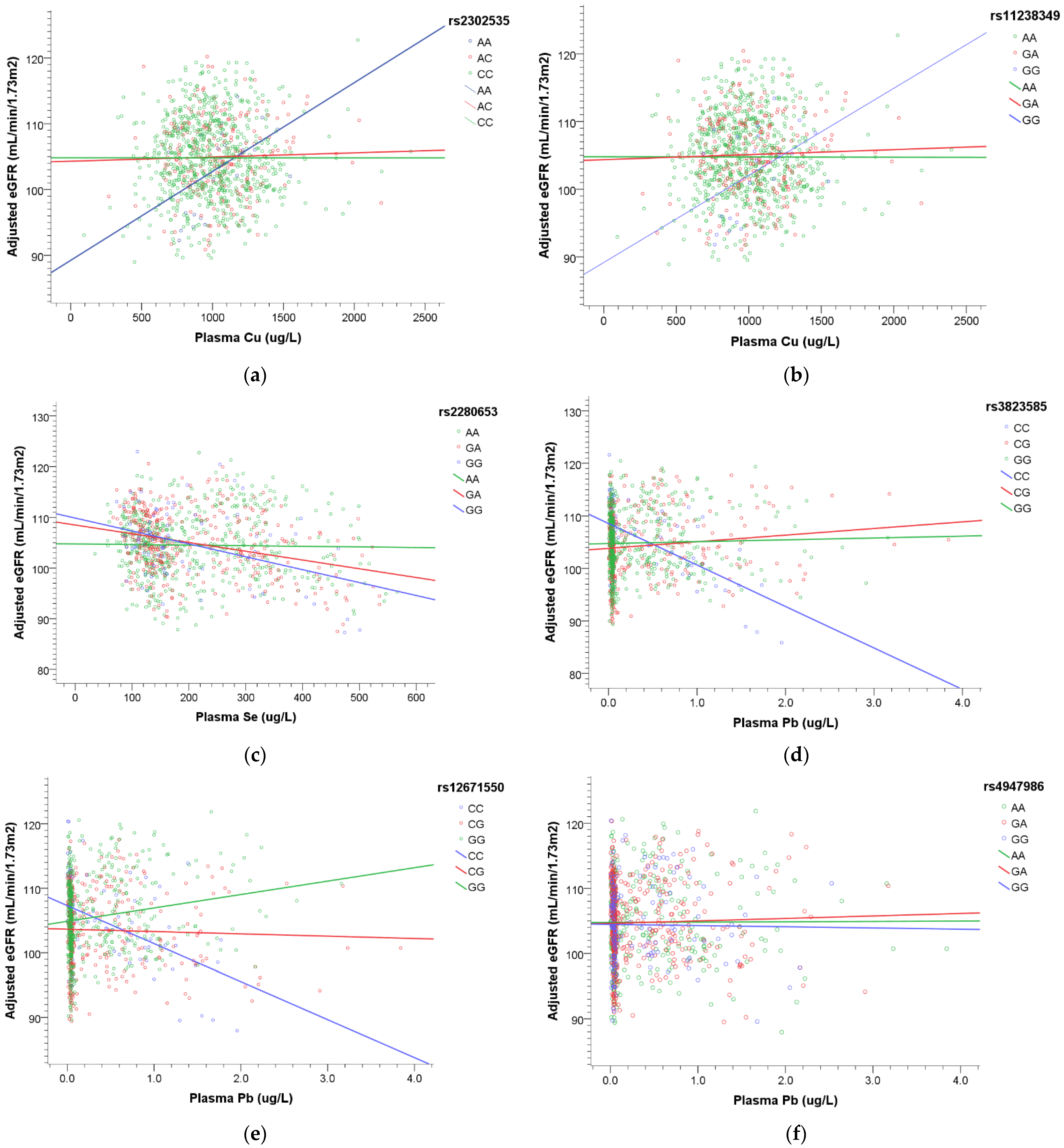The Association of Renal Function and Plasma Metals Modified by EGFR and TNF-α Gene Polymorphisms in Metal Industrial Workers and General Population
Abstract
:1. Introduction
2. Materials and Methods
2.1. Study Population and Renal Function Measurement
2.2. Analyses of Plasma Metals
2.3. Genotyping
2.4. Statistical Analyses
3. Results
3.1. Basic Information and Analysis of Study Population
3.2. The Association between Renal Function and SNPs
3.3. The Association between Renal Function and Metals
3.4. The Associations between Renal Function, Metals, and SNPs
3.5. The Interactions between Metals and SNPs on Renal Function
4. Discussion
5. Conclusions
Author Contributions
Funding
Institutional Review Board Statement
Informed Consent Statement
Data Availability Statement
Acknowledgments
Conflicts of Interest
References
- Bikbov, B.; Purcell, C.A.; Levey, A.S.; Smith, M.; Abdoli, A.; Abebe, M.; GBD Chronic Kidney Disease Collaboration. Global, regional, and national burden of chronic kidney disease, 1990–2017: A systematic analysis for the Global Burden of Disease Study 2017. Lancet 2020, 395, 709–733. [Google Scholar] [CrossRef] [Green Version]
- Jha, V.; Garcia-Garcia, G.; Iseki, K.; Li, Z.; Naicker, S.; Plattner, B.; Saran, R.; Wang, A.Y.; Yang, C.W. Chronic kidney disease: Global dimension and perspectives. Lancet 2013, 382, 260–272. [Google Scholar] [CrossRef]
- Moody, E.C.; Coca, S.G.; Sanders, A.P. Toxic Metals and Chronic Kidney Disease: A Systematic Review of Recent Literature. Curr. Environ. Health Rep. 2018, 5, 453–463. [Google Scholar] [CrossRef] [PubMed]
- Liu, Y.; Yuan, Y.; Xiao, Y.; Li, Y.; Yu, Y.; Mo, T.; Jiang, H.; Li, X.; Yang, H.; Xu, C.; et al. Associations of plasma metal concentrations with the decline in kidney function: A longitudinal study of Chinese adults. Ecotoxicol. Environ. Saf. 2020, 189, 110006. [Google Scholar] [CrossRef]
- Sanders, A.P.; Mazzella, M.J.; Malin, A.J.; Hair, G.M.; Busgang, S.A.; Saland, J.M.; Curtin, P. Combined exposure to lead, cadmium, mercury, and arsenic and kidney health in adolescents age 12-19 in NHANES 2009-2014. Environ. Int. 2019, 131, 104993. [Google Scholar] [CrossRef]
- Reilly, R.; Spalding, S.; Walsh, B.; Wainer, J.; Pickens, S.; Royster, M.; Villanacci, J.; Little, B.B. Chronic Environmental and Occupational Lead Exposure and Kidney Function among African Americans: Dallas Lead Project II. Int. J. Environ. Res. Public Health 2018, 15, 2875. [Google Scholar] [CrossRef] [PubMed] [Green Version]
- Costa, L.G.; Eaton, D.L. Gene–Environment Interactions: Fundamentals of Ecogenetics; John Wiley & Sons: Hoboken, NJ, USA, 2006; p. 450. [Google Scholar]
- Schlessinger, J. Ligand-induced, receptor-mediated dimerization and activation of EGF receptor. Cell 2002, 110, 669–672. [Google Scholar] [CrossRef] [Green Version]
- Rayego-Mateos, S.; Rodrigues-Diez, R.; Morgado-Pascual, J.L.; Valentijn, F.; Valdivielso, J.M.; Goldschmeding, R.; Ruiz-Ortega, M. Role of Epidermal Growth Factor Receptor (EGFR) and Its Ligands in Kidney Inflammation and Damage. Mediat. Inflamm. 2018, 2018, 8739473. [Google Scholar] [CrossRef] [Green Version]
- Zeng, F.; Singh, A.B.; Harris, R.C. The role of the EGF family of ligands and receptors in renal development, physiology and pathophysiology. Exp. Cell Res. 2009, 315, 602–610. [Google Scholar] [CrossRef] [Green Version]
- Kim, B.W.; Kim, S.K.; Heo, K.W.; Bae, K.B.; Jeong, K.H.; Lee, S.H.; Kim, T.H.; Kim, Y.H.; Kang, S.W. Association between epidermal growth factor (EGF) and EGF receptor gene polymorphisms and end-stage renal disease and acute renal allograft rejection in a Korean population. Ren. Fail. 2020, 42, 98–106. [Google Scholar] [CrossRef] [Green Version]
- Mehaffey, E.; Majid, D.S.A. Tumor necrosis factor-alpha, kidney function, and hypertension. Am. J. Physiol. Renal. Physiol. 2017, 313, F1005–F1008. [Google Scholar] [CrossRef] [Green Version]
- Majid, D.S. Tumor necrosis factor-alpha and kidney function: Experimental findings in mice. Adv. Exp. Med. Biol. 2011, 691, 471–480. [Google Scholar] [CrossRef] [PubMed]
- Chen, G.; Liu, B.; Li, H.; Mai, Z.; Zhang, L.; Li, M.; Liu, L.; Chen, S.; Chen, J.; Liu, Y. Ethnicity-Stratified Analysis of the Association between TNF-alpha Genetic Polymorphisms and Acute Kidney Injury: A Systematic Review and Meta-Analysis. Biomed. Res. Int. 2020, 2020, 5262351. [Google Scholar] [CrossRef] [PubMed]
- Singh, K.; Prasad, K.N.; Mishra, P.; Singh, S.K.; Kharwar, N.K.; Prasad, N.; Gupta, A.; Srivastava, J.K. Association of tumour necrosis factor-alpha polymorphism in patients with end stage renal disease. Nephrology 2015, 20, 387–391. [Google Scholar] [CrossRef] [PubMed]
- Paustenbach, D.J.; Tvermoes, B.E.; Unice, K.M.; Finley, B.L.; Kerger, B.D. A review of the health hazards posed by cobalt. Crit. Rev. Toxicol. 2013, 43, 316–362. [Google Scholar] [CrossRef]
- Nastoulis, E.; Karakasi, M.V.; Couvaris, C.M.; Kapetanakis, S.; Fiska, A.; Pavlidis, P. Greenish-blue gastric content: Literature review and case report on acute copper sulphate poisoning. Forensic. Sci. Rev. 2017, 29, 77–91. [Google Scholar]
- Barceloux, D.G. Zinc. J. Toxicol. Clin. Toxicol. 1999, 37, 279–292. [Google Scholar] [CrossRef]
- MacFarquhar, J.K.; Broussard, D.L.; Melstrom, P.; Hutchinson, R.; Wolkin, A.; Martin, C.; Burk, R.F.; Dunn, J.R.; Green, A.L.; Hammond, R.; et al. Acute selenium toxicity associated with a dietary supplement. Arch. Intern. Med. 2010, 170, 256–261. [Google Scholar] [CrossRef] [Green Version]
- Chen, C.H.; Yang, J.H.; Chiang, C.W.K.; Hsiung, C.N.; Wu, P.E.; Chang, L.C.; Chu, H.W.; Chang, J.; Song, I.W.; Yang, S.L.; et al. Population structure of Han Chinese in the modern Taiwanese population based on 10,000 participants in the Taiwan Biobank project. Hum. Mol. Genet. 2016, 25, 5321–5331. [Google Scholar] [CrossRef] [Green Version]
- Earley, A.; Miskulin, D.; Lamb, E.J.; Levey, A.S.; Uhlig, K. Estimating equations for glomerular filtration rate in the era of creatinine standardization: A systematic review. Ann. Intern. Med. 2012, 156, 785–795. [Google Scholar] [CrossRef]
- Taiwan Biobank. Available online: https://www.twbiobank.org.tw/new_web_en/index.php (accessed on 24 July 2021).
- Purcell, S.; Neale, B.; Todd-Brown, K.; Thomas, L.; Ferreira, M.A.; Bender, D.; Maller, J.; Sklar, P.; de Bakker, P.I.; Daly, M.J.; et al. PLINK: A tool set for whole-genome association and population-based linkage analyses. Am. J. Hum. Genet. 2007, 81, 559–575. [Google Scholar] [CrossRef] [Green Version]
- Anderson, C.A.; Pettersson, F.H.; Clarke, G.M.; Cardon, L.R.; Morris, A.P.; Zondervan, K.T. Data quality control in genetic case-control association studies. Nat. Protoc. 2010, 5, 1564–1573. [Google Scholar] [CrossRef] [Green Version]
- Craddock, N.J.; Jones, I.R. Wellcome Trust Case Control Consortium. Genome-wide association study of 14,000 cases of seven common diseases and 3,000 shared controls. Nature 2007, 447, 661–678. [Google Scholar] [CrossRef] [Green Version]
- Marker, M.; Grubl, A.; Riedl, O.; Heinze, G.; Pohanka, E.; Kotz, R. Metal-on-metal hip implants: Do they impair renal function in the long-term? A 10-year follow-up study. Arch. Orthop. Trauma Surg. 2008, 128, 915–919. [Google Scholar] [CrossRef]
- Matsumoto, M.; Makino, Y.; Tanaka, T.; Tanaka, H.; Ishizaka, N.; Noiri, E.; Fujita, T.; Nangaku, M. Induction of renoprotective gene expression by cobalt ameliorates ischemic injury of the kidney in rats. J. Am. Soc. Nephrol. 2003, 14, 1825–1832. [Google Scholar] [CrossRef] [Green Version]
- Oh, S.W.; Lee, Y.M.; Kim, S.; Chin, H.J.; Chae, D.W.; Na, K.Y. Cobalt chloride attenuates oxidative stress and inflammation through NF-kappaB inhibition in human renal proximal tubular epithelial cells. J. Korean Med. Sci. 2014, 29 (Suppl. 2), S139–S145. [Google Scholar] [CrossRef] [Green Version]
- Price, K.A.; Filiz, G.; Caragounis, A.; Du, T.; Laughton, K.M.; Masters, C.L.; Sharples, R.A.; Hill, A.F.; Li, Q.X.; Donnelly, P.S.; et al. Activation of epidermal growth factor receptor by metal-ligand complexes decreases levels of extracellular amyloid beta peptide. Int. J. Biochem. Cell Biol. 2008, 40, 1901–1917. [Google Scholar] [CrossRef] [PubMed]
- Price, K.A.; Caragounis, A.; Paterson, B.M.; Filiz, G.; Volitakis, I.; Masters, C.L.; Barnham, K.J.; Donnelly, P.S.; Crouch, P.J.; White, A.R. Sustained activation of glial cell epidermal growth factor receptor by bis(thiosemicarbazonato) metal complexes is associated with inhibition of protein tyrosine phosphatase activity. J. Med. Chem. 2009, 52, 6606–6620. [Google Scholar] [CrossRef]
- Fung, C.; Zhou, P.; Joyce, S.; Trent, K.; Yuan, J.M.; Grandis, J.R.; Weissfeld, J.L.; Romkes, M.; Weeks, D.E.; Egloff, A.M. Identification of epidermal growth factor receptor (EGFR) genetic variants that modify risk for head and neck squamous cell carcinoma. Cancer Lett. 2015, 357, 549–556. [Google Scholar] [CrossRef] [PubMed] [Green Version]
- Bashir, N.A.; Ragab, E.S.; Khabour, O.F.; Khassawneh, B.Y.; Alfaqih, M.A.; Momani, J.A. The Association between Epidermal Growth Factor Receptor (EGFR) Gene Polymorphisms and Lung Cancer Risk. Biomolecules 2018, 8, 53. [Google Scholar] [CrossRef] [PubMed] [Green Version]
- Dong, L.M.; Brennan, P.; Karami, S.; Hung, R.J.; Menashe, I.; Berndt, S.I.; Yeager, M.; Chanock, S.; Zaridze, D.; Matveev, V.; et al. An analysis of growth, differentiation and apoptosis genes with risk of renal cancer. PLoS ONE 2009, 4, e4895. [Google Scholar] [CrossRef] [PubMed] [Green Version]
- Hajeer, A.H.; Hutchinson, I.V. Influence of TNFalpha gene polymorphisms on TNFalpha production and disease. Hum. Immunol. 2001, 62, 1191–1199. [Google Scholar] [CrossRef]
- Elahi, M.M.; Asotra, K.; Matata, B.M.; Mastana, S.S. Tumor necrosis factor alpha -308 gene locus promoter polymorphism: An analysis of association with health and disease. Biochim. Biophys. Acta 2009, 1792, 163–172. [Google Scholar] [CrossRef] [PubMed] [Green Version]
- Sanchez-Fructuoso, A.I.; Perez-Flores, I.; Valero, R.; Moreno, M.A.; Fernandez-Arquero, M.; Urcelay, E.; Fernandez-Perez, C.; Santiago, J.L. The Polymorphism -308G/A of Tumor Necrosis Factor-alpha Gene Modulates the Effect of Immunosuppressive Treatment in First Kidney Transplant Subjects Who Suffer an Acute Rejection. J. Immunol. Res. 2016, 2016, 2197595. [Google Scholar] [CrossRef] [PubMed] [Green Version]
- Ellingsen, D.G.; Moller, L.B.; Aaseth, J. Handbook on the Toxicology of Metals, 4th ed.; Elsevier B.V.: Oxford, UK, 2015; pp. 765–786. [Google Scholar]
- De Ruyck, K.; Sabbe, N.; Oberije, C.; Vandecasteele, K.; Thas, O.; De Ruysscher, D.; Lambin, P.; Van Meerbeeck, J.; De Neve, W.; Thierens, H. Development of a multicomponent prediction model for acute esophagitis in lung cancer patients receiving chemoradiotherapy. Int. J. Radiat. Oncol. Biol. Phys. 2011, 81, 537–544. [Google Scholar] [CrossRef]
- Chen, Y.; Xin, X.; Li, J.; Xu, J.; Yu, X.; Li, T.; Mo, Z.; Hu, Y. RTK/ERK pathway under natural selection associated with prostate cancer. PLoS ONE 2013, 8, e78254. [Google Scholar] [CrossRef] [Green Version]
- Alfthan, G.; Neve, J. Reference values for serum selenium in various areas-evaluated according to the TRACY protocol. J. Trace Elem. Med. Biol. 1996, 10, 77–87. [Google Scholar] [CrossRef]
- Harari, F.; Sallsten, G.; Christensson, A.; Petkovic, M.; Hedblad, B.; Forsgard, N.; Melander, O.; Nilsson, P.M.; Borne, Y.; Engstrom, G.; et al. Blood Lead Levels and Decreased Kidney Function in a Population-Based Cohort. Am. J. Kidney Dis. 2018, 72, 381–389. [Google Scholar] [CrossRef] [Green Version]
- Kim, R.; Rotnitsky, A.; Sparrow, D.; Weiss, S.; Wager, C.; Hu, H. A longitudinal study of low-level lead exposure and impairment of renal function. The Normative Aging Study. JAMA 1996, 275, 1177–1181. [Google Scholar] [CrossRef]
- Weaver, V.M.; Lee, B.K.; Todd, A.C.; Ahn, K.D.; Shi, W.; Jaar, B.G.; Kelsey, K.T.; Lustberg, M.E.; Silbergeld, E.K.; Parsons, P.J.; et al. Effect modification by delta-aminolevulinic acid dehydratase, vitamin D receptor, and nitric oxide synthase gene polymorphisms on associations between patella lead and renal function in lead workers. Environ. Res. 2006, 102, 61–69. [Google Scholar] [CrossRef]
- Wu, M.T.; Kelsey, K.; Schwartz, J.; Sparrow, D.; Weiss, S.; Hu, H. A delta-aminolevulinic acid dehydratase (ALAD) polymorphism may modify the relationship of low-level lead exposure to uricemia and renal function: The normative aging study. Environ. Health Perspect. 2003, 111, 335–341. [Google Scholar] [CrossRef] [PubMed] [Green Version]
- Li, C.Y.; Sung, F.C. A review of the healthy worker effect in occupational epidemiology. Occup. Med. 1999, 49, 225–229. [Google Scholar] [CrossRef] [Green Version]




| Variable | Total n = 1003 | Non-Metal Workers n = 627 | Metal Workers n = 376 | p Value |
|---|---|---|---|---|
| Gender | 0.056 | |||
| Male | 514 (51.2) | 334 (53.3) | 180 (47.9) | |
| Female | 489 (48.8) | 293 (46.7) | 196 (52.1) | |
| Smoking | <0.001 | |||
| Yes | 213 (21.2) | 90 (14.4) | 123 (32.7) | |
| No | 790 (78.8) | 537 (85.6) | 253 (67.3) | |
| Age (year) | 43.54 ± 10.03 | 43.16 ± 9.50 | 44.18 ± 10.83 | 0.117 |
| BMI (kg/m2) | 24.40 ± 3.96 | 24.01 ± 3.45 | 25.05 ± 4.62 | <0.001 |
| SBP (mmHg) | 117.82 ± 16.62 | 115.00 ± 16.22 | 122.53 ± 16.23 | <0.001 |
| DBP (mmHg) | 72.01 ± 11.32 | 72.74 ± 10.96 | 70.79 ± 11.81 | 0.008 |
| Sugar (mg/dL) | 94.69 ± 25.69 | 92.89 ± 18.38 | 97.70 ± 34.41 | 0.004 |
| TC (mg/dL) | 202.08 ± 37.41 | 197.81 ± 35.42 | 209.20 ± 39.54 | <0.001 |
| Uric acid (mg/dL) | 5.75 ± 1.54 | 5.74 ± 1.55 | 5.76 ± 1.52 | 0.832 |
| ALT (IU/L) | 26.21 ± 19.77 | 24.97 ± 19.22 | 28.26 ± 20.53 | 0.011 |
| Creatinine (mg/dL) | 0.77 ± 0.17 | 0.78 ± 0.17 | 0.75 ± 0.16 | 0.009 |
| eGFR1 (mL/min/1.73 m2) | 104.67 ± 12.65 | 104.15 ± 12.26 | 105.53 ± 13.24 | 0.095 |
| eGFR2 (mL/min/1.73 m2) | 100.41 ± 20.16 | 99.56 ± 20.31 | 101.82 ± 19.85 | 0.086 |
| Co (μg/L) | 0.85 ± 0.29 | 0.78 ± 0.29 | 0.97 ± 0.26 | <0.001 |
| Cu (μg/L) | 1003.54 ± 270.94 | 951.81 ± 266.22 | 1088.93 ± 257.00 | <0.001 |
| Zn (μg/L) | 851.35 ± 276.60 | 792.91 ± 260.44 | 947.82 ± 275.82 | <0.001 |
| Se (μg/L) | 207.41 ± 107.83 | 144.73 ± 45.47 | 311.91 ± 100.48 | <0.001 |
| As (μg/L) | 6.07 ± 8.10 | 4.72 ± 3.32 | 8.31 ± 12.20 | <0.001 |
| Pb (μg/L) | 0.34 ± 0.52 | 0.05 ± 0.04 | 0.83 ± 0.58 | <0.001 |
Publisher’s Note: MDPI stays neutral with regard to jurisdictional claims in published maps and institutional affiliations. |
© 2021 by the authors. Licensee MDPI, Basel, Switzerland. This article is an open access article distributed under the terms and conditions of the Creative Commons Attribution (CC BY) license (https://creativecommons.org/licenses/by/4.0/).
Share and Cite
Chen, T.-H.; Huang, J.-J.; Lee, H.-Y.; Kung, W.-S.; Luo, K.-H.; Lu, J.-Y.; Chuang, H.-Y. The Association of Renal Function and Plasma Metals Modified by EGFR and TNF-α Gene Polymorphisms in Metal Industrial Workers and General Population. Int. J. Environ. Res. Public Health 2021, 18, 8965. https://doi.org/10.3390/ijerph18178965
Chen T-H, Huang J-J, Lee H-Y, Kung W-S, Luo K-H, Lu J-Y, Chuang H-Y. The Association of Renal Function and Plasma Metals Modified by EGFR and TNF-α Gene Polymorphisms in Metal Industrial Workers and General Population. International Journal of Environmental Research and Public Health. 2021; 18(17):8965. https://doi.org/10.3390/ijerph18178965
Chicago/Turabian StyleChen, Tzu-Hua, Joh-Jong Huang, Hsiang-Ying Lee, Wei-Shyang Kung, Kuei-Hau Luo, Jia-Yi Lu, and Hung-Yi Chuang. 2021. "The Association of Renal Function and Plasma Metals Modified by EGFR and TNF-α Gene Polymorphisms in Metal Industrial Workers and General Population" International Journal of Environmental Research and Public Health 18, no. 17: 8965. https://doi.org/10.3390/ijerph18178965
APA StyleChen, T.-H., Huang, J.-J., Lee, H.-Y., Kung, W.-S., Luo, K.-H., Lu, J.-Y., & Chuang, H.-Y. (2021). The Association of Renal Function and Plasma Metals Modified by EGFR and TNF-α Gene Polymorphisms in Metal Industrial Workers and General Population. International Journal of Environmental Research and Public Health, 18(17), 8965. https://doi.org/10.3390/ijerph18178965







